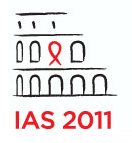6th IAS Conference on HIV Pathogenesis, Treatment and Prevention 17-20 July 2011, Rome
1 August 2011. Related: Conference reports, Conference index, IAS 6th Rome 2011.
 Introduction
Introduction
The biannual IAS Conference on HIV Pathogenesis, Treatment and Prevention is more scientifically focused than the World AIDS Conference held in alternate years and is considerably smaller. This makes both attending and reporting more manageable and concentrated.
This year the conference was held in Rome. While plenary lectures were held in the concert halls designed by Renzo Piano (the architect designing the Shard Tower in London), smaller meetings were often in rooms with a capacity of only 50 people and the poster and exhibition halls were less than ideal, being held in the venues garages.
Even prior to the conference, the frenzy to gain media coverage filled email boxes with press releases that made it clear that the meeting would be dominated by prevention studies.
The leading prevention reports, first and most importantly, involved the reduction in transmission from use of HIV treatment for HIV-positive people. The risk is not reduced to zero, but it is getting close, especially when condoms remain the mainstay of prevention work. It means that if a condom breaks, slips off, or is not used at all, an HIV positive person who has had an undetectable viral load for over six months would find it difficult to transmit HIV.
The shift in medical consensus is dramatic. While the Swiss Statement three years ago was met with anger publically from many prominent doctors, in private most also recognised that viral load was the driving factor behind transmission risk. It was good to hear Pietro Vernazza who authored the Swiss paper ask Myron Cohen after presenting the results of HPTN 052 on whether Cohens new results had prompted a change of heart.
IAS in Rome included four oral presentations from the HPTN 052 study. Together they showed that HIV-positive people in high incidence resource limited settings (predominantly Africa, Asia and Latin America) who started treatment at a CD4 count of 350-550 reduced the risk of transmitting HIV to their HIV-negative primary partner by 96% compared to people waiting until their CD4 count was 250. This was a study that intensely integrated other prevention strategies – condom provision and counselling reduced transmission too, but treatment extended this significantly further.
The second way that treatment reduces transmission was supported by new studies reporting the benefits of PEP/PrEP strategies. These involved HIV negative people taking a daily pill of tenofovir/FTC, or tenofovir alone, which led to reductions in their risk of catching HIV.
As with previous meetings, the conference has an open-access searchable abstract database online.
However, many oral presentations are not included as webcasts or PowerPoint slides.
The Programme at a glance can be searched for key words but requires a free software upgrade Silverlight which is quick and easy to do. Then from this page you can search abstracts or presentations.
Sessions with PowerPoint slides or webcasts have relevant icons next to them. As with previous years, the PowerPoint links on the left under the session time are not active, so to download PowerPoint files scroll down to the bottom of the session page
We have also included reports from the 3rd International Workshop on HIV Pediatrics immediately preceding IAS 2011. This small annual meeting is becoming quite established and although abstracts are often submitted to both meetings, in this one they may often get an oral presentation instead of just a poster. For those specialising in paediatrics this meeting is a welcome opportunity to present and discuss work in a dedicated forum. Abstracts and presentations are online. We have included references from both meetings in our paediatric reports.
http://regist2.virology-education.com/abstractbook/2011_8.pdf
http://regist2.virology-education.com/2011/3HIVped/15_July.html
Reports in this issue of HTB include:
Unless stated otherwise, all references are the Programme and Abstracts of the 16th IAS Conference on HIV Pathogenesis, Treatment and Prevention, 1720 July 2011, Rome.

